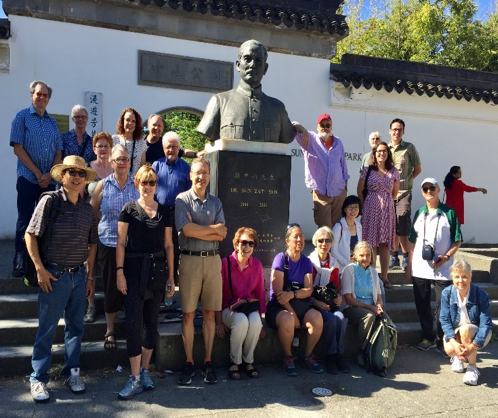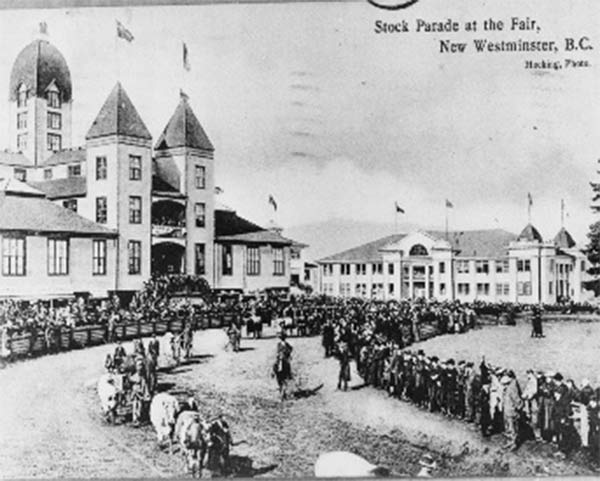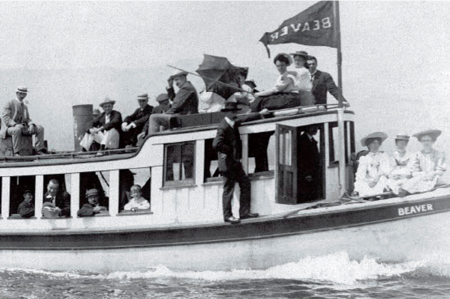Summaries of Talks and Field Trips - 2017
Glimpses of the Past through description, related books and internet connections
Christ Church Cathedral
Christ Church Cathedral, Vancouver’s oldest surviving church building, at the corner of Burrard Street and West Georgia has undergone several major expansions and renovations over its 127 year history. Ian’s slide show presentation and building tour provided a detailed history of the church and the many financial challenges it has faced in preserving a heritage building. It was shocking to learn that it was almost demolished in the 1970’s. The last renovation completed in 2016 included a new bell tower and the replacement of the roof. Underpinning the success of the church is the commitment to an expanded community role and open door policies.
City On Edge: a rebellious century of Vancouver protests, riots, and strikes

For more than a century, photojournalists at The Vancouver Sun and The Province have been on the scene to capture those times when the city stood up, took to the streets, and made some noise. From the 1900 salmon fishermen’s strike to the 2017 women’s march, Vancouver has a long history of making its viewpoints heard, and in some cases, felt. Retired PNG librarian Kate Bird, author of City On Edge: a rebellious century of Vancouver protests, riots, and strikes and Vancouver in the Seventies: photos from a decade that changed the city presented a slide show of images from Vancouver’s rich history of protest activism.
The Last Gang in Town: The Epic Story of the Clark Park Gang vs. the Vancouver Police
Decades before organized crime syndicates brought sensational drug wars to Vancouver, street gangs held sway over its unruly east side. None was considered tougher or more feared than the Clark Park gang, a wild, two-fisted crew of characters from Vancouver’s post-1960s counterculture. In 1972, after a number of headline-making riots and clashes with police ’ including an infamous altercation outside a Rolling Stones concert ’ the Clark Parkers became the target of a secret undercover police squad. Their hostile interactions culminated in a notorious police shooting, resulting in the death of a Clark Park gang member. Author/historian Aaron Chapman presented previously unpublished photos and police documents, and anecdotes told by surviving gang members and police officers who spoke for the first time on the subject, making for a compelling portrait of the early 1970s that put the spotlight on the after-dark underbelly of Vancouver’s not-so-distant criminal past.
The Japanese-Canadian Internment — 75 Years After
Since 2017 is the 75th anniversary of the incarceration of 22,000 Japanese Canadians, it is fitting that we review and discuss this regrettable chapter in Canadian history. Tosh Kitagawa talked about the anti-Asian environment that prevailed from BC joining Confederation in 1871 until 1949, including the exploitation of Chinese labour in the building of the railway from 1880’1884 and the Anti-Asian riots in Vancouver in 1907.
Mary Kitagawa chronicled her personal history from 1941’1949, beginning with the forcible removal of her father by the RCMP in front of her and her young siblings and his exile to work on the road camps. Her saga continued with her family in the horse barns at Hastings Park and their time spent in seven different incarceration camps until their freedom finally came in 1949. Her narrative concluded with her struggle to obtain Honourary Degrees for the 76 Japanese-Canadian students expelled from UBC in 1942.
Chinatown Field Trip
Chinatown is an important cultural landscape. Since non-native settlement began, there has been a Chinese presence on Burrard Inlet and Chinatown is as old as the city. Yet, as all communities do, Chinatown is evolving and facing change. An aging population, changing business climate and different immigration patterns have all had their effect on the district, but it endures. On this walk we explored its history and development. Moments that stood out included insights into the distinctive local influence on the area’s historic buildings; the story of Vancouver’s four separate Chinatowns across time; conversation about a laneway tenement building that passes unseen by most visitors; and reference to the parts of China-town that are new but respectful of the community’s cultural heritage. Above all, John told the story of Chinatown from the perspective of the Chinese inhabitants themselves, a useful reminder that history offers many different perspectives.
The Lure of Stanley Park's Totem Poles
Stanley Park’s totem poles first began attracting visitors and locals in the 1920s. Today with over 3.5 million visitors each year, they are the number one tourist destination in the entire province. The first totem pole, from the Skeena River, was donated to Stanley Park in 1903, and four more were acquired in 1922. Over the years the Park’s collection of poles has changed, from the original location at Lumberman’s Arch to the present location, in 1963, at Brockton Point. Since the Coast Salish peoples, whose territory includes the site of what is now Stanley Park, did not traditionally carve totem poles, the collection of poles that merged in the park reflected the culture of northern First Nations, including poles carved or restored by the renowned Haida carver Bill Reid and Kwakwaka’wakw carver Doug Cranmer. The longtime absence of work reflecting local Salish culture led in 2008 to the erection of three marvelous Welcome Gateways created by Musqueam artist Susan Point. They surround a cluster of totem poles that tell the diverse stories of the Northwest Coast’s Indigenous peoples.
Morag Maclachan’s legacy: The untold story of Noel Annance
VHS member Morag Maclachan (1920-2011) left a legacy of an important publication, The Fort Langley Journals (UBC Press, 1998), along with extensive research on Noel Annance, an Abenaki, from just outside of Montreal, who was among Fort Langley’s founders in the winter of 1824-25. Delta’s Annacis Island (now an industrial island in the Fraser River situated between New Westminster and Delta, originally called Annance’s Island) is named after him. Just before her death and unable to complete Annance’s story, Morag asked Jean Barman to do so. The result is Abenaki Daring: The Life and Writings of Noel Annance, 1792-1869 (McGill-Queen’s University Press, 2016), which tells the story of an indigenous man who by virtue of having attended Dartmouth College, due to his maternal descent from child captives, was all his life caught between two ways of being. He was too indigenous to be accepted in the fur trade, too highly educated to fit in on returning home in Lower Canada [Quebec] in 1834. Noel Annance did not crumple, but rather used his pen to detail to the government Indigenous people’s plight in a Canada in the making. His letters showed that the exclusionary policies generally considered to have originated with the Indian Act of 1876 had previously been in place.
Historic Clan and Associations Buildings of Vancouver’s Chinatown
Apr 27, 2017 MoV John Atkin and Tom Wanklin
Vancouver’s Chinatown is not an historical entity frozen in time, but an area which has evolved and continues to evolve to meet the ever changing needs of this vibrant part of our collective urban memory. The historic brick and mortar structures of the area reflect a dynamic crossover of styles between Chinese, European and a hybrid Gold Mountain design which even returned in form to southern China. As well, the incorporated ornate balconies recall both the ancestor hall of the clan areas and the residential buildings of Guangdong province. From their ground floors of shops, to the mixed use mezzanine second floors, to the third storey residential and the fourth floor assembly halls, they reflected clan and benevolent associations answering a much needed early mutual support. Even though the Chinese community over the past half century has spread throughout the lower mainland, the historical Chinatown has remained a spiritual centre for many and joint efforts are being made to preserve its importance.
The task at hand is to preserve the cultural history of the area with sustainable, often 100 year old, upgraded buildings which reflects their evolution. The city’ss aim, along with the various Chinese associations who still control the buildings, is to revitalize the economy and protect the heritage and thread of history, all the while being respectful and mindful of the complex dynamics that continue to drive the area.
Queen's Park, New Westminster
Queen’s Park, a 75 acre mixed-use New Westminster public park (the first such park conceived in the colony of British Columbia) was established on June 13, 1887 to celebrate the Jubilee year of Queen Victoria’s reign. As early as 1859, Colonel Richard C. Moody, as commissioner of land and works and founder of New Westminster, gushed over the site in a letter to Governor James Douglas: “What a grand old park this hill would make!”
Almost 30 years later it evolved as a romantic nature park with non-native exotic shrubs, trees and flowers being suffused with West Coast native flora. Over time, Queen’s Park also incorporated built structures and was from 1905 to 1929 also the site of the Dominion Exhibition. During WWI the exhibition buildings served as a barracks for recruits and in WWI the local Westminster Regiment used the area for combat training and exercises. A practical breathing spot for local working people the park continues to host sports competitions, including lacrosse and hockey.
How Vancouver Changed in the 1980s
From Vancouver City Alderman (1973-1980) to Mayor (1980-1986) to MLA (1986-1991) to Premier of the Province of British Columbia (1991-1996) Michael Harcourt has long marshaled a career in progressive politics. Starting as a new lawyer, a call from the organizers of SPOTA (Strathcona Property Owners and Tenants Association) saw him successfully lead the charge on their behalf against all manner of advocacy groups who wanted to cut up the city with freeways and in doing so tear down established neighbourhoods. Consequently, Vancouver today is the only major North American city without freeways running through it, instead, relying more on public transportation. He also spent a good part of his time as mayor helping set the stage for Expo 86 which brought the world to the city, changing the city’s dynamic. As a result of these two actions and others and, with the help of similarly like-minded people, Vancouver has enjoyed the reputation of being one of the most livable cities in the world. Mike says, with a grin, that after leading dynamic Vancouver, he took a demotion when he became the Premier of the Province of British Columbia. Hardly the case, but that’s another story. (see: https://en.wikipedia.org/wiki/Mike_Harcourt)
* Vancouver Incorporation Day Luncheon
The Ferries of Indian Arm
As prosperous times before the First World War created a local surge in immigration as well as a house and ship building boom in Vancouver, comparatively affluent Vancouverites began looking for scenic summer retreats close to the city. However, without roads or bridges to access the North Arm of Burrard Inlet (Indian Arm), reliable ferries became essential to developing these new recreational properties.
As a result, during 70 years of the 20th century scheduled ferry runs from Vancouver to steamer landings on the fjord, travelling post offices and floating grocery stores became unique and critical services to the many small communities scattered along Indian Arm. This unique service has been key to shaping the history and psyche of Indian Arm residents of today. (See: Ralph Drew’s Ferries and Fjord: The History of Indian Arm, Its Ferries & Docks, Travelling Post Offices & Floating Grocery Stores, Belcarra, BC: Ralph Drew, 2015)
Early Vancouver Artists: surviving while being creative
From the time that Vancouver was carved out of old growth forest little more than one hundred and twenty years ago, artists – painters to sculptors to photographers – sought to nourish their souls while sustaining a livelihood. It was a tough job for artists working within an early city environment of newly arrived loggers, fishermen and workers whose main job it was to feed their families on meager workers’ incomes let alone contemplate the artistic qualities of their fellow Vancouverites. The artists themselves, coalescing under various organizational umbrellas and exhibiting in small private art galleries, became teachers and illustrators in order to sustain themselves. Very few made a living solely by their various forms of art output. For the wives of those who had managed to find their way into the upper middle class or higher, expressions of their own artistic abilities assured their place in upper class gentility. Consequently, an awareness of early art in Vancouver is integral to the study of the city’s long road to maturity.
A Half Century of Civic Politics
Vancouver politics from the city’s 1886 inception have shown pockets of brilliance; other times, not so. Nonetheless, by the time of its post-WWII emergence, the city was perceived by some to be a “dirty, grimy backwater”. Remarkably, the city has evolved with forward looking policies and is now deemed to be one of the livable cities in the world. This has been done through a variety of civic political parties with such initials as NPA, TEAM, COPE and Vision each of whom, at one time or another, have captured the political centre and by doing so, have espoused similar values of keeping the water supply pristine, the dirty water flowing outward in a non-polluting way and by upgrading the infrastructure incrementally year by year. The biggest problem now is the difference in vision of the Provincial Government which is still building greater access for more cars to come into the City and the vision of the City which is to continue reducing the number of cars within the city.








![Chinese Freemason's Building, Vancouver [Image: FlickRiver]](https://vancouver-historical-society.ca/wp-content/uploads/2023/08/ChineseFreemasons.jpg)




